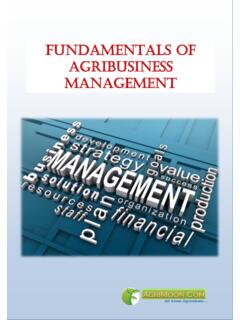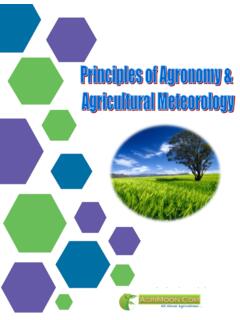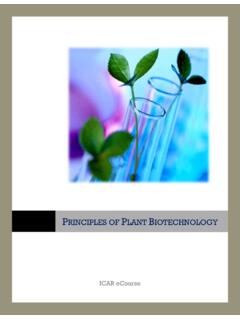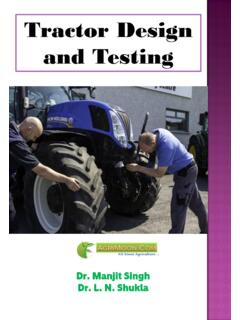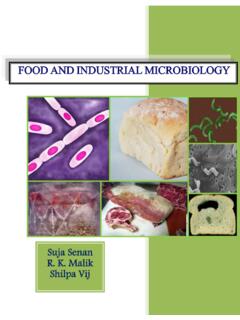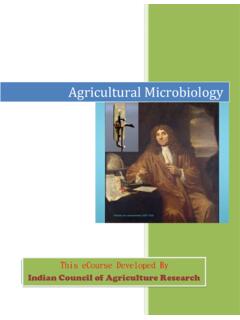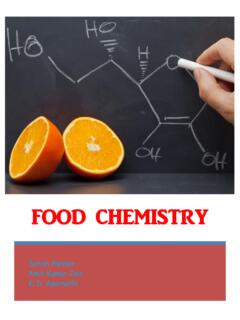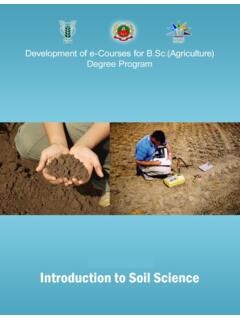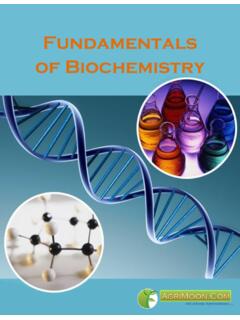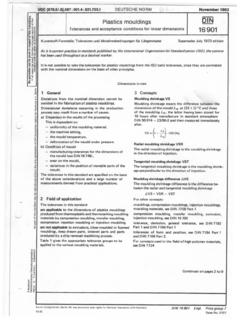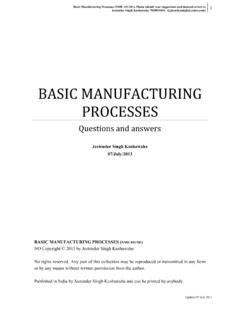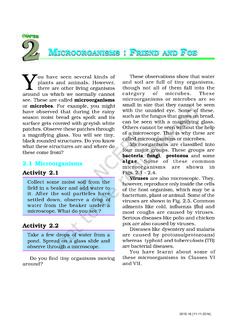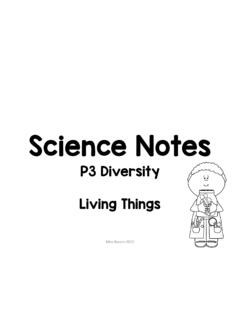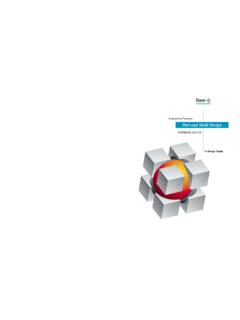Transcription of Food Processing Plant Design & Layout - AgriMoon
1 food Processing Plant Design & Layout Mr. A. K. Sharma Dr. B. K. Kumbhar food Processing Plant Design & Layout -: Course Content Developed By :- Mr. A. K. Sharma Associate Professor College of food Processing Technology and Bio-Energy, AAU -:Content Reviewed by :- Dr. B. K. Kumbhar Professor processand food of technology, GBPUAT,Pantanagar Index Lesson Page No Module- 1. Introduction of food Plant Design and Layout Lesson 1. Introduction to Plant Design , situations, difference and considerations 5-9 Lesson 2. food Plant Design process 10-13 Lesson 3. Introduction to feasibility study and analysis 14-23 Module- 2. Location and site selection for food plants Lesson 4. Introduction to Plant location 24-35 Module- 3. food Plant size, utilities and services Lesson 5. food Plant size and utilities 36-40 Lesson and Ventilation 41-43 Module- 4.
2 food Plant Layout Introduction, Planning and Experimentation Lesson 7. Plant Layout 44-50 Lesson 8. Layout Design Procedure 51-58 Lesson 9. Experimentation in Pilot Plant 59-60 Module- 5. Symbols used for food Plant Design and Layout Lesson 10. Symbols used for food Plant Design and Layout 61-70 Lesson 11. food Processing enterprise 71-80 Module- 6. food Processing enterprise and engineering economics Lesson 12. Engineering economics 81-83 Module- 7. Process scheduling and operation Lesson 13 Process schedule 84-86 Lesson 14: Plant operation 87-97 Module 8. Building materials and construction Lesson 15. Building materials 98-110 Lesson16. Building construction 111-128 ** ** This Book Download From e-course of ICAR Visit for Other Agriculture books, News, Recruitment, Information, and Events at Give FeedBack & Suggestion at Send a Massage for daily Update of Agriculture on WhatsApp +91-7900 900 676 Disclaimer: The information on this website does not warrant or assume any legal liability or responsibility for the accuracy, completeness or usefulness of the courseware contents.
3 The contents are provided free for noncommercial purpose such as teaching, training, research, extension and self learning. ** ** Connect With Us: food Processing Plant Design & Layout 5 Module- 1. Introduction of food Plant Design and Layout Lesson 1. Introduction to Plant Design , situations, difference and considerations Introduction The manufacturing of food products of consistent quality and nutritional value at affordable cost is essential to the success of the food industry today. The efficient use of resources is, therefore, growing concern for all involved in handling of raw materials and energy for Processing , production, distribution and retailing of food . The unique features of the raw materials of the food Processing industries such as seasonality, perishability and variability in conjunction with sophistication required for Processing to maintain high quality standards, necessitates special attention towards skilled technical manpower, effective technologies, efficient machinery in the food Plant .
4 Plant Design refers to the overall Design of a manufacturing enterprise / facility. It moves through several stages before it is completed. The stages involved are: identification and selection of the product to be manufactured, feasibility analysis and appraisal, Design , economic evaluation, Design report preparation, procurement of materials including Plant and machinery, construction, installation and commissioning. The Design should consider the technical and economic factors, various unit operations involved, existing and potential market conditions etc. Plant Design specifies Flow charts and Plant layouts spell out interconnections and raw material flows, permanent/temporary storage, shop facilities, office spaces, delivery and shipping facilities, access ways Equipments, utilities and services to be used Required instrumentation and interconnections for process monitoring and controls Strategic site location, plan and elevation They also often provide economic analyses of Plant profitability in terms of various product demand and price and material cost scenarios.
5 Plant Design situations may arise due to one or more of the following: Design and erection of a completely new Plant Design and erection of an addition to the existing Plant the facility or Plant operations and subsequent expansion restricted by a poor site, thereby necessitating the setting up of the Plant at a new site addition of some new product to the existing range food Processing Plant Design & Layout 6 adoption of some new process /replacement of some existing equipment modernization / automation of the existing facility expansion of the Plant capacity relocating the existing Plant at a new site because of new economic, social, legal or political factors Differences in the Design of food Processing and non- food Processing plants Many of the elements of Plant Design are the same for food plants as they are for other plants particularly those Processing industrial chemicals.
6 However, there are many significant differences, basically in the areas of equipment selection and sizing, and in working space Design . These differences stem from the ways in which the Processing of foods differs from the Processing of industrial chemicals. Such differences occur because of the following considerations: The storage life of foods is relatively limited and strongly affected by temperature, pH, water activity, maturity, prior history, and initial microbial contamination levels. Very high and verifiable levels of product safety and sterility have to be provided. Foods are highly susceptible to microbial attack and insect and rodent infestation. Fermentations are used in producing various foods and bio chemicals. Successful Processing requires the use of conditions, which ensure the dominance of desired strains of microorganisms growth or activity.
7 Enzyme-catalyzed processes are used or occur in many cases. These, like microbial growth and fermentation are very sensitive to temperature, pH, water activity and other environmental conditions. Many foods are still living organisms or bio chemically active long after harvest or slaughter. In some cases foods ( ripening cheeses) contain active living micro organisms, which induce chemical transformations for long periods of time. Crop-based food raw materials may only be available in usable form on a seasonal basis. Therefore, Plant Design may involve the modelling of crop availability. food raw materials are highly variable and that variability is enhanced by the ageing of raw material and uncontrollable variations in climatic conditions. The biological and cellular nature and structural complexity of foods causes special heat-transfer, mass-transfer and component separation problems.
8 Foods are frequently solid. Heat and mass-transfer problems in solids have to be created in ways that are different than those used for liquid and gas streams. The kinetics of microbe and enzyme inactivation during thermally induced sterilization and blanching and heat-transfer in the solids being sterilized or blanched are strongly linked. food Processing Plant Design & Layout 7 food Processing generates wastes with high BOD loads. Foods are often chemically complex systems whose components tend to react with one another. Certain types of reactions, Maillard reactions, oxidative rancidification, hydrolytic rancidification and enzymatic browning tend to occur with a high degree of frequency. The engineering properties of foods and biological material are less well known and more variable than those of pure chemicals and simple mixtures of chemicals.
9 Vaguely defined sensory attributes often have to be preserved, generated or modified. These require sensory testing. Raw material variation, minor Processing changes and trace contaminants leached from Processing equipment and packages can often cause significant changes in these attributes. Frequently, we do not have mechanistic bases for linking these attributes to Processing conditions and equipment Design . Much current food engineering and food science research activity at universities is designed to provide such linkages. In the case of foods, prototype products have to be consumer tested so as to assure market acceptability before plants for large scale production are built. Mechanical working is sometimes used to induce desired textural changes. Examples include kneading and sponge mixing during the making of bread, the calendaring of pastry dough, shearing during extrusion texturization.
10 Packaging in small containers is often used or required; and strong-package-product interactions exist. Packaging often requires care to maintain integrity of closure, reproducibility of fill elimination of air from head spaces and prevention of subsequent moisture and oxygen transfer. Segregation often causes problems in the packaging of powdered foods. Aseptic packaging is starting to be widely used. food Processing techniques and formulations are sometimes constrained by standards of identity and good manufacturing practice regulations and codes. food Processing is an art to a certain extent. Engineers and technologists are frequently uncertain as to weather portions of that art are really justified or necessary. It is sometimes difficult for them to translate the necessary portions of that art into quantifiable heat-transfer and chemical reaction processes on which rational designs can be based.
